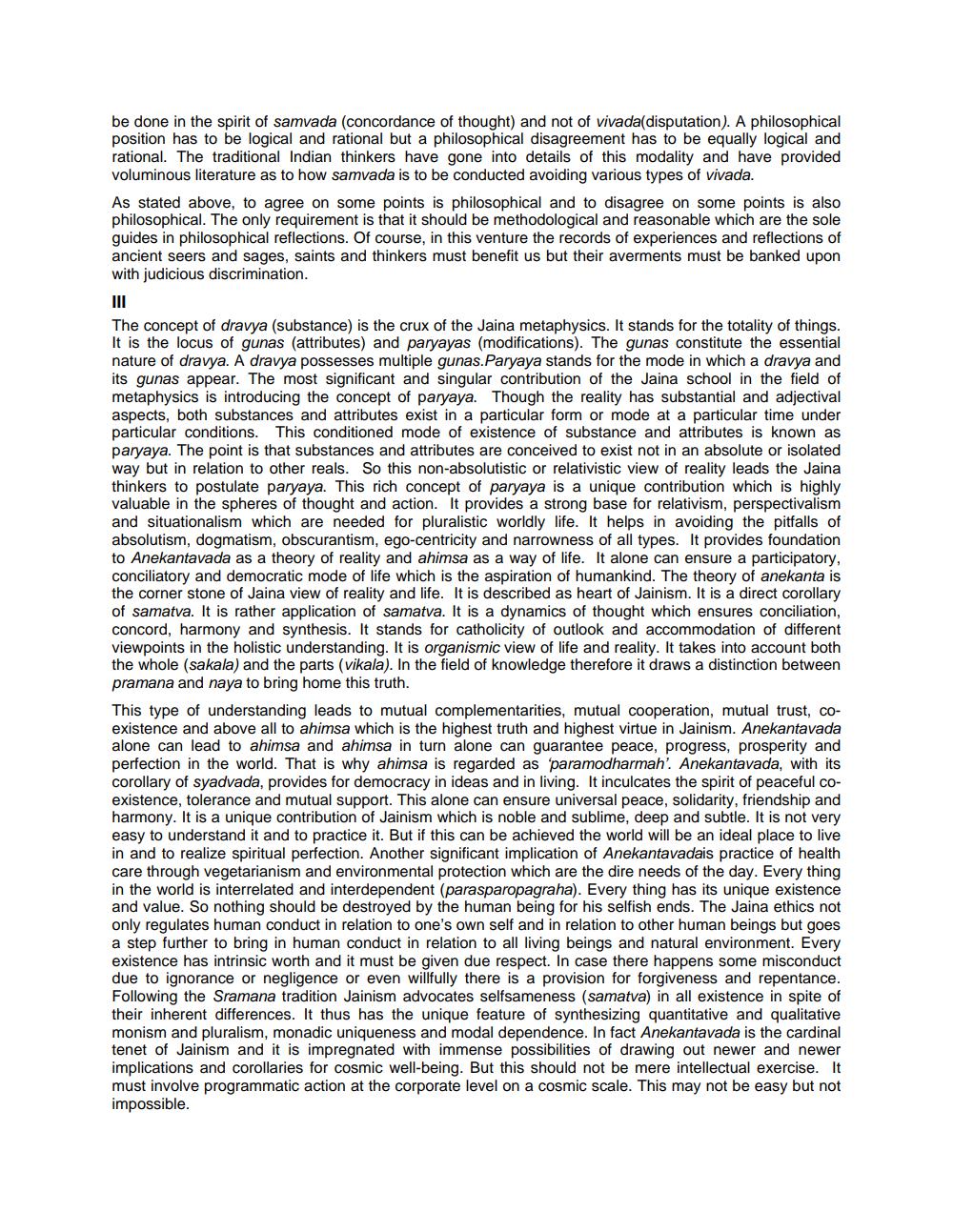Book Title: Jaina View Towards Philosophical Inquiry and Harmonious Ways of Living Author(s): S R Bhatt Publisher: ZZZ Unknown View full book textPage 2
________________ be done in the spirit of samvada (concordance of thought) and not of vivada(disputation). A philosophical position has to be logical and rational but a philosophical disagreement has to be equally logical and rational. The traditional Indian thinkers have gone into details of this modality and have provided voluminous literature as to how samvada is to be conducted avoiding various types of vivada. As stated above, to agree on some points is philosophical and to disagree on some points is also philosophical. The only requirement is that it should be methodological and reasonable which are the sole guides in philosophical reflections. Of course, in this venture the records of experiences and reflections of ancient seers and sages, saints and thinkers must benefit us but their averments must be banked upon with judicious discrimination. The concept of dravya (substance) is the crux of the Jaina metaphysics. It stands for the totality of things. It is the locus of gunas (attributes) and paryayas (modifications). The gunas constitute the essential nature of dravya. A dravya possesses multiple gunas.Paryaya stands for the mode in which a dravya and its gunas appear. The most significant and singular contribution of the Jaina school in the field of metaphysics is introducing the concept of paryaya. Though the reality has substantial and adjectival aspects, both substances and attributes exist in a particular form or mode at a particular time under particular conditions. This conditioned mode of existence of substance and attributes is known as paryaya. The point is that substances and attributes are conceived to exist not in an absolute or isolated way but in relation to other reals. So this non-absolutistic or relativistic view of reality leads the Jaina thinkers to postulate paryaya. This rich concept of paryaya is a unique contribution which is highly valuable in the spheres of thought and action. It provides a strong base for relativism, perspectivalism and situationalism which are needed for pluralistic worldly life. It helps in avoiding the pitfalls of absolutism, dogmatism, obscurantism, ego-centricity and narrowness of all types. It provides foundation to Anekantavada as a theory of reality and ahimsa as a way of life. It alone can ensure a participatory, conciliatory and democratic mode of life which is the aspiration of humankind. The theory of anekanta is the corner stone of Jaina view of reality and life. It is described as heart of Jainism. It is a direct corollary of samatva. It is rather application of samatva. It is a dynamics of thought which ensures conciliation, concord, harmony and synthesis. It stands for catholicity of outlook and accommodation of different viewpoints in the holistic understanding. It is organismic view of life and reality. It takes into account both the whole (sakala) and the parts (vikala). In the field of knowledge therefore it draws a distinction between pramana and naya to bring home this truth. This type of understanding leads to mutual complementarities, mutual cooperation, mutual trust, coexistence and above all to ahimsa which is the highest truth and highest virtue in Jainism. Anekantavada alone can lead to ahimsa and ahimsa in turn alone can guarantee peace, progress, prosperity and perfection in the world. That is why ahimsa is regarded as 'paramodharmah'. Anekantavada, with its corollary of syadvada, provides for democracy in ideas and in living. It inculcates the spirit of peaceful coexistence, tolerance and mutual support. This alone can ensure universal peace, solidarity, friendship and harmony. It is a unique contribution of Jainism which is noble and sublime, deep and subtle. It is not very easy to understand it and to practice it. But if this can be achieved the world will be an ideal place to live in and to realize spiritual perfection. Another significant implication of Anekantavadais practice of health care through vegetarianism and environmental protection which are the dire needs of the day. Every thing in the world is interrelated and interdependent (parasparopagraha). Every thing has its unique existence and value. So nothing should be destroyed by the human being for his selfish ends. The Jaina ethics not only regulates human conduct in relation to one's own self and in relation to other human beings but goes a step further to bring in human conduct in relation to all living beings and natural environment. Every existence has intrinsic worth and it must be given due respect. In case there happens some misconduct due to ignorance or negligence or even willfully there is a provision for forgiveness and repentance. Following the Sramana tradition Jainism advocates selfsameness (samatva) in all existence in spite of their inherent differences. It thus has the unique feature of synthesizing quantitative and qualitative monism and pluralism, monadic uniqueness and modal dependence. In fact Anekantavada is the cardinal tenet of Jainism and it is impregnated with immense possibilities of drawing out newer and newer implications and corollaries for cosmic well-being. But this should not be mere intellectual exercise. It must involve programmatic action at the corporate level on a cosmic scale. This may not be easy but not impossible.Page Navigation
1 2 3 4 5 6 7 8 9 10 11
